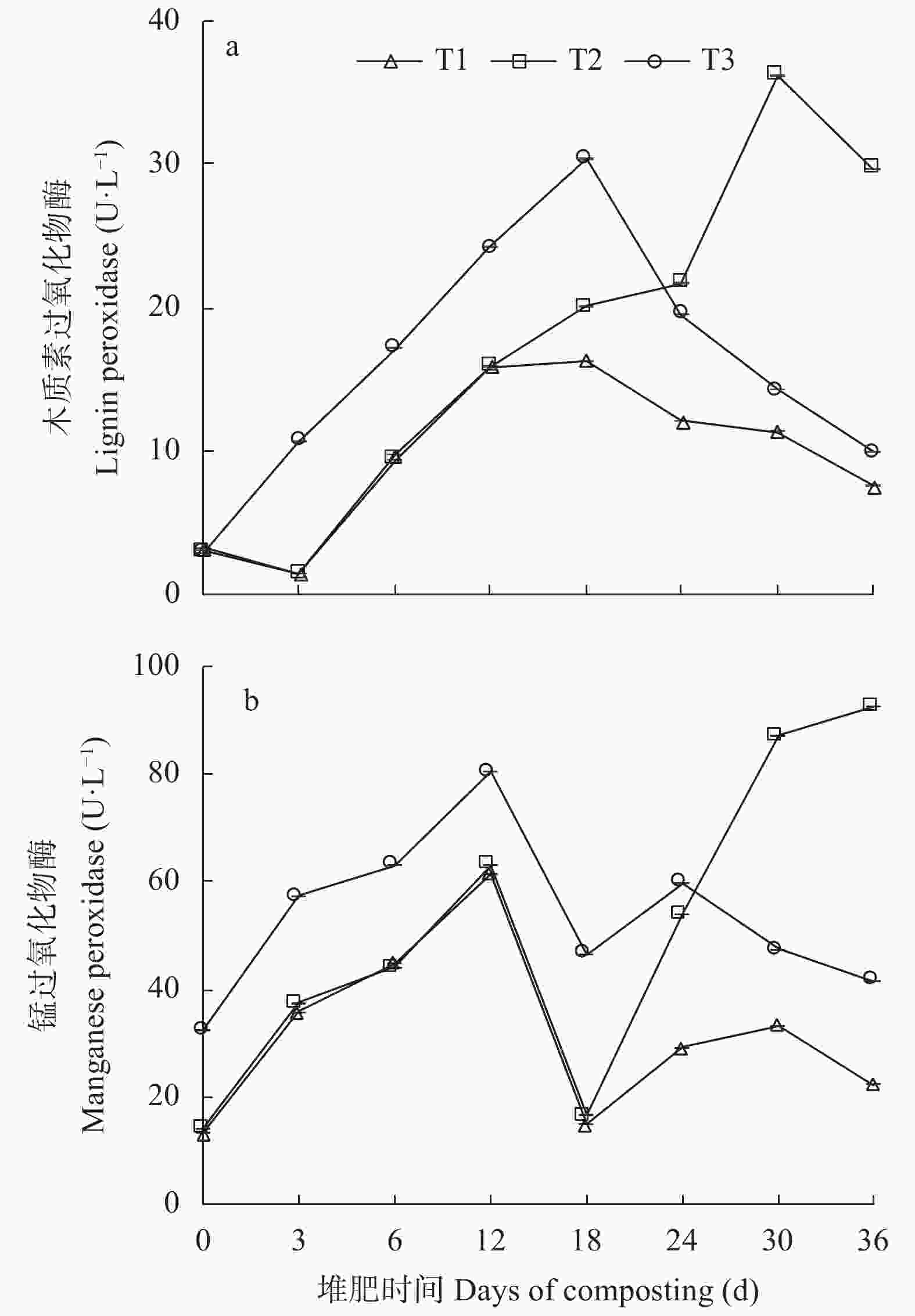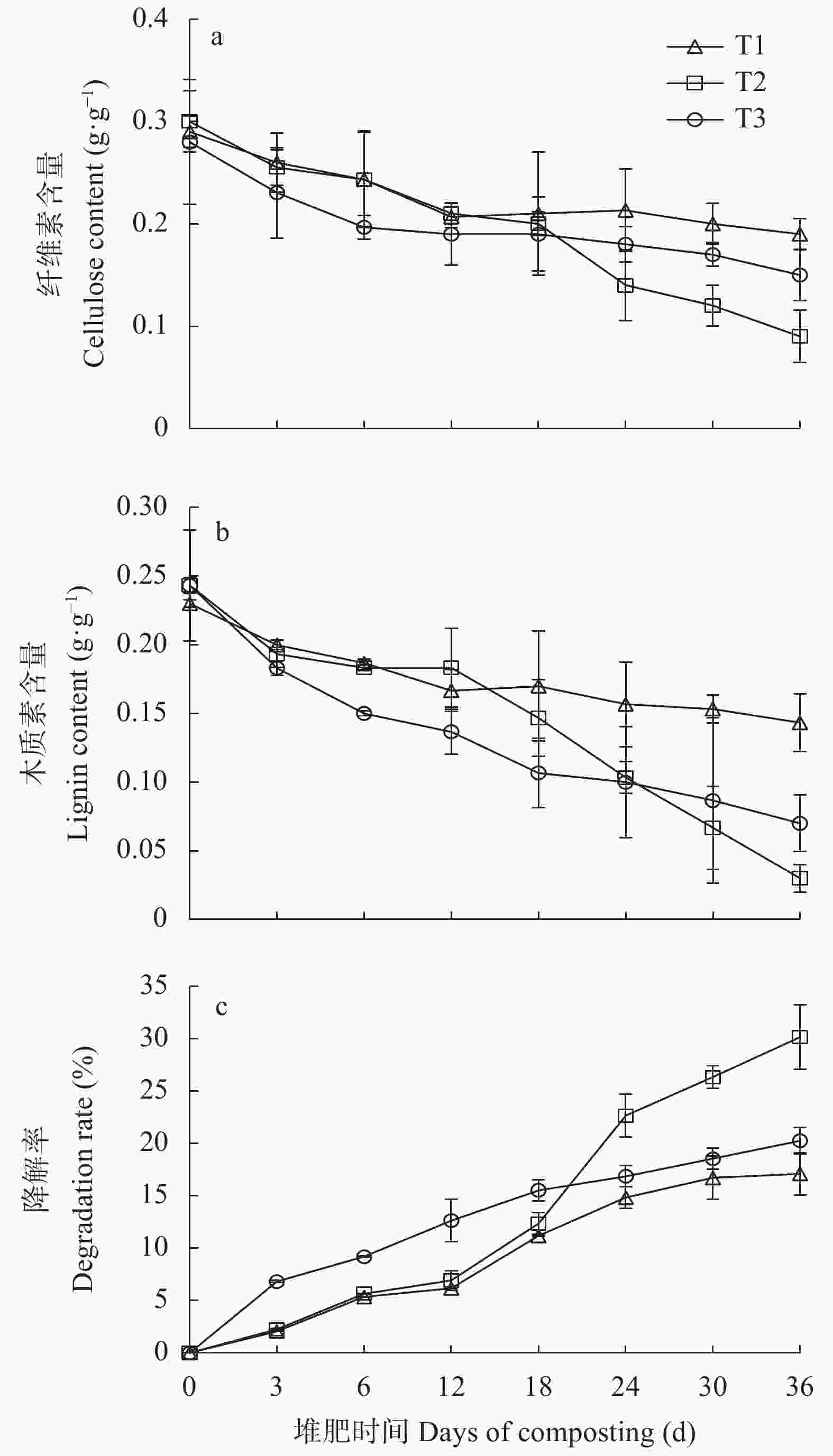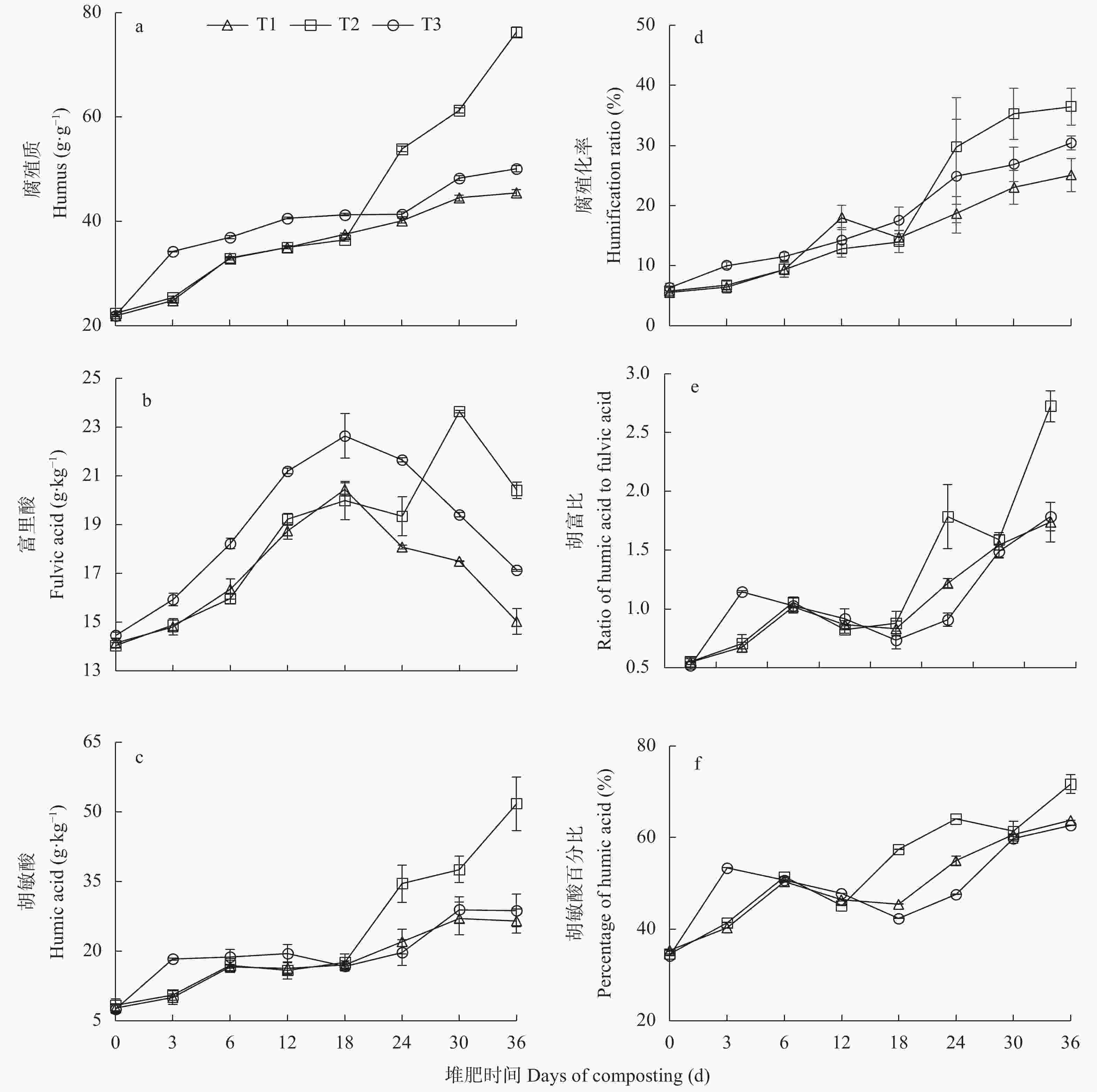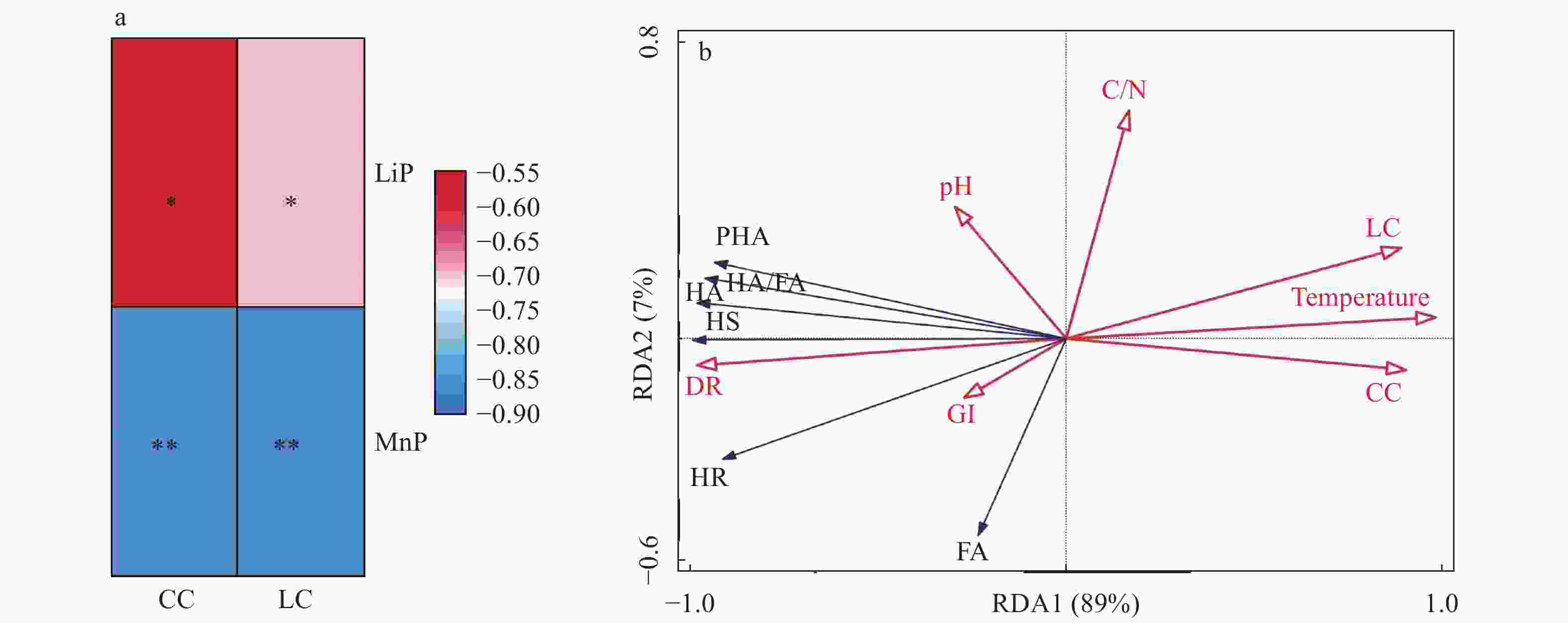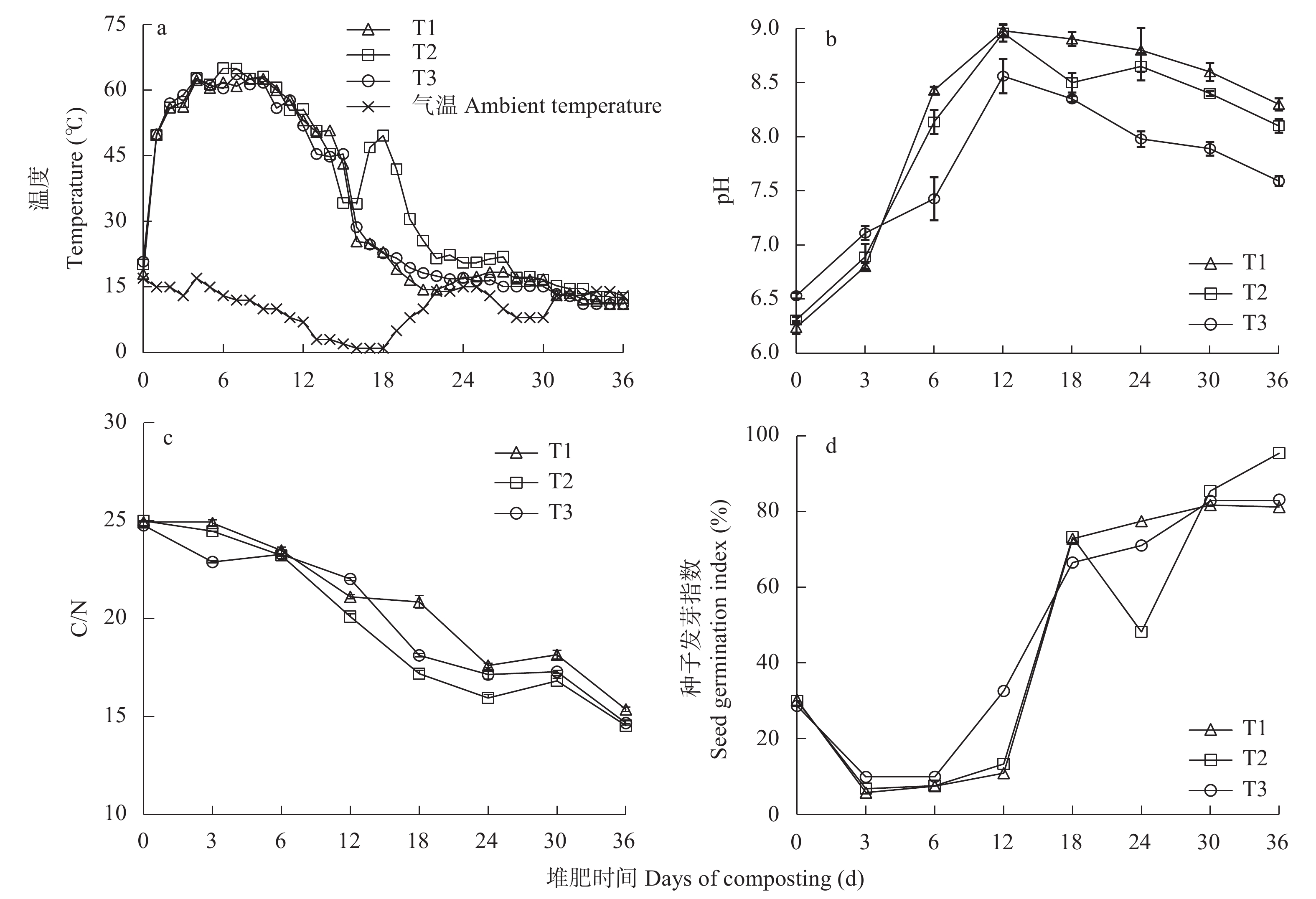Effect of Phanerochaete chrysosporium inoculation in different times of rice husk and chicken manure composting on humification of compost
-
摘要: 为了实现稻壳和鸡粪堆肥中木质纤维素的高效降解, 促进堆肥的腐殖化, 采用黄孢原毛平革菌(Phanerochaete chrysosporium)作为接种剂, 设置T1 (不接菌)、T2 [堆肥降温期(第18天)接菌]和T3 [堆肥初期(第0 天)接菌] 3个处理, 通过研究在不同堆肥时期接种黄孢原毛平革菌强化木质素和纤维素降解的作用, 关键酶活性变化及其与腐质化过程的偶联, 以确定接种黄孢原毛平革菌对堆肥腐殖化的促进作用。结果表明, 与T1处理相比, T2处理的木质素过氧化物酶和锰过氧化物酶活性、木质素和纤维素降解率和腐殖化程度均显著提高(P<0.05)。堆肥结束时, 与T1相比, T2的木质素和纤维素含量显著降低78.57%和52.63% (P<0.05), 与T3相比, T2木质素和纤维素含量显著降低57.14%和40.00% (P<0.05); T2腐殖质含量分别比T1和T3显著提高67.84%和52.33% (P<0.05)。此外, 多种腐熟指标表明T2处理的堆肥品质显著提高, 其腐殖化率、胡富比和胡敏酸百分比分别为51.64%、2.72和73.39%, 显著高于T1和T3处理(P<0.05)。RDA和相关性分析结果表明, 木质素和纤维素的降解与堆肥腐殖化指标呈显著负相关性(P<0.05), 木质过氧化物酶和锰过氧化物酶活性与木质素和纤维素含量呈显著负相关(P<0.05)。因此, 在堆肥降温期接种黄孢原毛平革菌通过提高木质过氧化物酶和锰过氧化物酶活性, 促进了木质素和纤维素的深度降解, 从而强化堆肥的腐殖化过程, 提高了堆肥品质。Abstract: In the process of rice processing, a large amount of agricultural organic solid waste (e.g., rice husk) is produced, and composting is an effective way to realize resource utilization of rice husk. However, lignin in rice husk has a complex structure and is not easy to be degraded, and the high content of lignin limits the composting of rice husk, and exogenous inoculation of Phanerochaete chrysosporium can accelerate the degradation of lignocellulose. However, the effect of inoculation of P. chrysosporium in different composting times on the humification process of rice husk composting is not clear. Therefore, in this study, rice husk and chicken manure were used as raw materials, P. chrysosporium was inoculated in the 18th day of composting (cooling stage of composting, T2), and 0 day of composting (T3, beginning of composting), for aerobic composting, with T1 (no inoculation) as the control. By analyzing composting temperature, pH, C/N, seed germination rate, lignin peroxidase, manganese peroxidase, lignin content, cellulose content and humus to explore the effect of inoculating P. chrysosporium at different composting times on the degradation of lignin and cellulose, the changes of key enzyme activities and their coupling with the process of humification, the promoting effect of inoculating P. chrysosporium on composting humification was determined. The results showed that the lignin peroxidase (LiP) and manganese perosidase (MnP) activities, lignin and cellulose degradation rates and humification degree were significantly increased after P. chrysosporium inoculation during the cooling period (T2). At the end of composting, the cellulose content of T2 treatment decreased from 0.30 g∙g−1 of initial compost to 0.09 g∙g−1, and the lignin content decreased from 0.24 g∙g−1 of initial compost to 0.03 g∙g−1. Compared with T1, the contents of lignin and cellulose decreased by 78.57% and 52.63% (P<0.05) under T2 treatment, and 57.14% and 40.00% (P<0.05) under T3 treatment. T2 treatment increased the humus content by 67.84% and 52.33% (P<0.05), respectively, compared with T1 and T3. Various maturity indexes showed that the compost quality of T2 treatment was significantly improved, the humification rate (HR), ratio of humic acid to fulvic acid (HA/FA) and percentage of humic acid (PHA) reached 51.64%, 2.72 and 73.39%, respectively, significantly higher than T1 and T3 (P<0.05). The results of correlation analysis showed that the contents of lignin and cellulose were significantly negatively correlated with the activities of lignocellulosic degradation enzymes (LiP and MnP) (P<0.05, P<0.01); Redundancy analysis (RDA) showed that degradation rate (explanatory degree=88.2%, P=0.002), cellulose content (explanatory degree=74.3%, P=0.002) and lignin content (explanatory degree=72.5%, P=0.002) had the most significant effects on the maturity index. These results indicated that the degradation of lignin and cellulose promoted the formation of HS, the deep degradation of lignin and cellulose promoted the complexity of HS structure and made the HS structure more stable. Therefore, inoculation of P. chrysosporium in the cooling period of composting promoted the deep degradation of lignin and cellulose by improving the activities of LiP and MnP, thus strengthened the humification process of composting and improved the quality of compost, and provided theoretical basis for the composting production of rice husk.
-
Key words:
- Composting /
- Phanerochaete chrysosporium /
- Inoculation time /
- Rice husk /
- Chicken manure /
- Humification
-
图 1 不同时间接种黄孢原毛平革菌对堆肥过程中堆肥物料理化性质的影响
T1: 不接菌; T2: 堆肥第18天接菌; T3: 堆肥第0天接菌。
Figure 1. Changes of physicochemical properties of compost materials during composting with inoculation of Phanerochaete chrysosporium in different times
T1: no inoculation; T2: inoculation on the day 18; T3: inoculation on the day 0.
图 3 不同时间接种黄孢原毛平革菌对堆肥过程中堆肥物料纤维素含量、木质素含量和有机物料降解率的影响
T1: 不接菌; T2: 堆肥第18天接菌; T3: 堆肥第0天接菌。
Figure 3. Changes of cellulose content, lignin content and organic material degradation rate of compost materials during composting with inoculation of Phanerochaete chrysosporium in different times
T1: no inoculation; T2: inoculation on the day 18; T3: inoculation on the day 0.
图 4 不同时间接种黄孢原毛平革菌对堆肥过程中堆肥物料腐殖质组分和腐熟指标的影响
T1: 不接菌; T2: 堆肥第18天接菌; T3: 堆肥第0天接菌。
Figure 4. Changes of humus components contents and maturity indexes of compost materials during composting with inoculation of Phanerochaete chrysosporium in different times
T1: no inoculation; T2: inoculation on the day 18; T3: inoculation on the day 0.
图 5 木质纤维素含量与木质纤维素降解酶活性之间的相关性(a)及堆肥腐熟程度和理化参数之间的冗余分析(b)
*: P<0.05; **: P<0.01. LiP: 木质素过氧化物酶活性; MnP: 锰过氧化物酶活性; CC: 纤维素含量; LC: 木质素含量; GI: 种子发芽指数; DR: 有机物料降解率; HS: 腐殖质含量; HA: 胡敏酸含量; FA: 富里酸含量; HR: 腐殖化率; HA/FA: 胡富比; PHA: 胡敏酸百分比; Temperature: 温度。
Figure 5. Correlation between lignocellulose content and lignocellulose-degrading enzymes activities (a), and redundancy analysis between compost maturity indexes and compost physicochemical parameters (b)
LiP: lignin peroxidase activity; MnP: manganese peroxidase activity; CC: cellulose content; LC: lignin content; GI: seed germination index; DR: organic material degradation rate; HS: humus content; HA: humic acid content; FA: fulvic acid content; HR: humification rate; HA/FA: ratio of humic acid to fulvic acid; PHA: percentage of humic acid.
表 1 堆肥原料的基本理化性质
Table 1. Basic physicochemical properties of the compost raw materials
原料
Material总有机碳
Total organic carbon (g∙kg−1)总氮
Total nitrogen (g∙kg−1)水分
Moisture (%)C/N 鸡粪 Chicken manure 329.72 33.05 55.41 9.98 稻壳 Rice husk 448.75 5.39 9.79 83.26 -
[1] 武晋萍, 陈建文, 刘勇, 等. 鸡粪与中药渣共堆肥对抗生素抗性基因的影响[J]. 环境科学, 2019, 40(7): 3276−3284WU J P, CHEN J W, LIU Y, et al. Effect of co-composting of chicken manure with Chinese medicinal herbal residues on antibiotic resistance genes[J]. Environmental Science, 2019, 40(7): 3276−3284 [2] WU D, WEI Z M, GAO X Z, et al. Reconstruction of core microbes based on producing lignocellulolytic enzymes causing by bacterial inoculation during rice straw composting[J]. Bioresource Technology, 2020, 315: 123849 doi: 10.1016/j.biortech.2020.123849 [3] WU D, WEI Z M, QU F T, et al. Effect of Fenton pretreatment combined with bacteria inoculation on humic substances formation during lignocellulosic biomass composting derived from rice straw[J]. Bioresource Technology, 2020, 303: 122849 doi: 10.1016/j.biortech.2020.122849 [4] VOBĚRKOVÁ S, VAVERKOVÁ M D, BUREŠOVÁ A, et al. Effect of inoculation with white-rot fungi and fungal consortium on the composting efficiency of municipal solid waste[J]. Waste Management, 2017, 61: 157−164 doi: 10.1016/j.wasman.2016.12.039 [5] 张勇, 陈骥, 张锋. 有机废弃物降解过程酶作用及其调控机制的研究进展[J]. 生态与农村环境学报, 2020, 36(7): 842−853ZHANG Y, CHEN J, ZHANG F. A review on enzymatic degradation and its regulation mechanisms for organic wastes[J]. Journal of Ecology and Rural Environment, 2020, 36(7): 842−853 [6] TORTOSA G, TORRALBO F, MAZA-MÁRQUEZ P, et al. Assessment of the diversity and abundance of the total and active fungal population and its correlation with humification during two-phase olive mill waste (“alperujo”) composting[J]. Bioresource Technology, 2020, 295: 122267 doi: 10.1016/j.biortech.2019.122267 [7] LI S Y, LI J J, YUAN J, et al. The influences of inoculants from municipal sludge and solid waste on compost stability, maturity and enzyme activities during chicken manure composting[J]. Environmental Technology, 2017, 38(13/14): 1770−1778 [8] 唐菊, 段传人, 黄友莹, 等. 白腐菌木质素降解酶及其在木质素降解过程中的相互作用[J]. 生物技术通报, 2011(10): 32−36TANG J, DUAN C R, HUANG Y Y, et al. Characteristics of ligninolytic enzymes of white-rot fungus and their interactions in the process of lignin degradation[J]. Biotechnology Bulletin, 2011(10): 32−36 [9] ZHANG J C, ZENG G M, CHEN Y N, et al. Phanerochaete chrysosporium inoculation shapes the indigenous fungal communities during agricultural waste composting[J]. Biodegradation, 2014, 25(5): 669−680 doi: 10.1007/s10532-014-9690-5 [10] XU P, LAI C, ZENG G M, et al. Enhanced bioremediation of 4-nonylphenol and cadmium co-contaminated sediment by composting with Phanerochaete chrysosporium inocula[J]. Bioresource Technology, 2018, 250: 625−634 doi: 10.1016/j.biortech.2017.11.069 [11] CHEN Y, WANG Y Y, XU Z, et al. Enhanced humification of maize straw and canola residue during composting by inoculating Phanerochaete chrysosporium in the cooling period[J]. Bioresource Technology, 2019, 293: 122075 doi: 10.1016/j.biortech.2019.122075 [12] ZENG G M, YU M, CHEN Y N, et al. Effects of inoculation with Phanerochaete chrysosporium at various time points on enzyme activities during agricultural waste composting[J]. Bioresource Technology, 2010, 101(1): 222−227 doi: 10.1016/j.biortech.2009.08.013 [13] VAN SOEST P J, ROBERTSON J B, LEWIS B A. Methods for dietary fiber, neutral detergent fiber, and nonstarch polysaccharides in relation to animal nutrition[J]. Journal of Dairy Science, 1991, 74(10): 3583−3597 doi: 10.3168/jds.S0022-0302(91)78551-2 [14] 张陆, 曹玉博, 王惟帅, 等. 鸡粪添加对蔬菜废弃物堆肥腐殖化过程的影响[J]. 中国生态农业学报(中英文), 2022, 30(2): 258−267 doi: 10.12357/cjea.20210536ZHANG L, CAO Y B, WANG W S, et al. Effect of chicken manure addition on humification of vegetable waste in composting process[J]. Chinese Journal of Eco-Agriculture, 2022, 30(2): 258−267 doi: 10.12357/cjea.20210536 [15] CHI C P, CHU S H, WANG B, et al. Dynamic bacterial assembly driven by Streptomyces griseorubens JSD-1 inoculants correspond to composting performance in swine manure and rice straw co-composting[J]. Bioresource Technology, 2020, 313: 123692 doi: 10.1016/j.biortech.2020.123692 [16] DUAN M L, ZHANG Y H, ZHOU B B, et al. Effects of Bacillus subtilis on carbon components and microbial functional metabolism during cow manure-straw composting[J]. Bioresource Technology, 2020, 303: 122868 doi: 10.1016/j.biortech.2020.122868 [17] ZHAO X Y, XI B D, HE X S, et al. The impacts of metal ions on phytotoxicity mediate by microbial community during municipal solid waste composting[J]. Journal of Environmental Management, 2019, 242: 153−161 [18] WONG J W C, KARTHIKEYAN O P, SELVAM A. Biological nutrient transformation during composting of pig manure and paper waste[J]. Environmental Technology, 2017, 38(6): 754−761 doi: 10.1080/09593330.2016.1211747 [19] ZHANG Z C, ZHAO Y, YANG T X, et al. Effects of exogenous protein-like precursors on humification process during lignocellulose-like biomass composting: Amino acids as the key linker to promote humification process[J]. Bioresource Technology, 2019, 291: 121882 doi: 10.1016/j.biortech.2019.121882 [20] 李恕艳, 李吉进, 张邦喜, 等. 菌剂对鸡粪堆肥腐殖质含量品质的影响[J]. 农业工程学报, 2016, 32(S2): 268−274LI S Y, LI J J, ZHANG B X, et al. Influence of inoculants on content and quality of humus during chicken manure composting[J]. Transactions of the Chinese Society of Agricultural Engineering, 2016, 32(S2): 268−274 [21] WU J Q, ZHAO Y, ZHAO W, et al. Effect of precursors combined with bacteria communities on the formation of humic substances during different materials composting[J]. Bioresource Technology, 2017, 226: 191−199 doi: 10.1016/j.biortech.2016.12.031 [22] 徐成, 刘国涛, 王政, 等. 添加腐熟堆肥对厨余垃圾堆肥腐殖质形成的影响[J]. 环境科学与技术, 2020, 43(8): 122−127XU C, LIU G T, WANG Z, et al. Effect of matured compost addition on the formation of humus in kitchen waste composting[J]. Environmental Science & Technology, 2020, 43(8): 122−127 [23] ANTIZAR-LADISLAO B, BECK A J, SPANOVA K, et al. The influence of different temperature programmes on the bioremediation of polycyclic aromatic hydrocarbons (PAHs) in a coal-tar contaminated soil by in-vessel composting[J]. Journal of Hazardous Materials, 2007, 144(1/2): 340−347 -





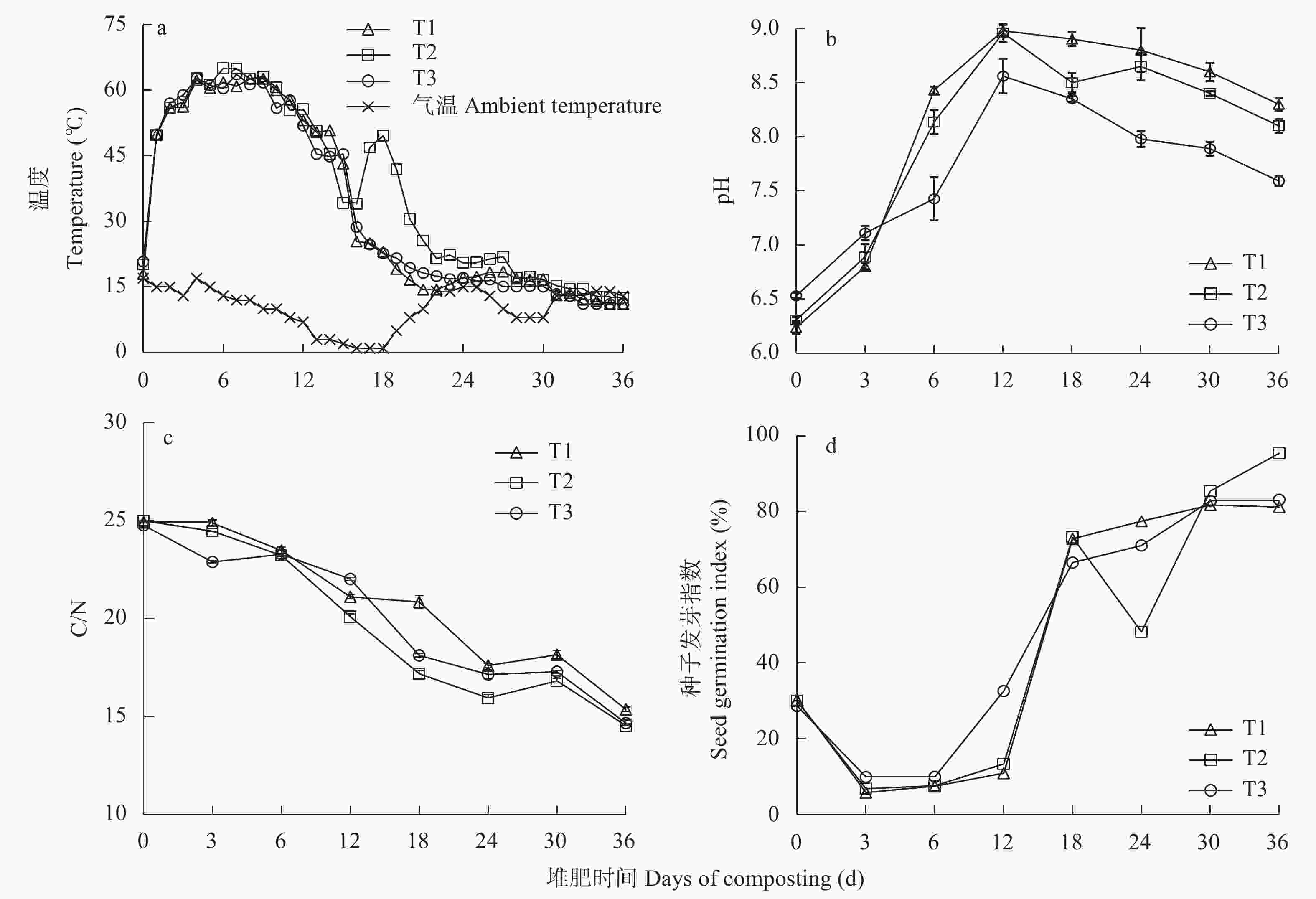
 下载:
下载:
